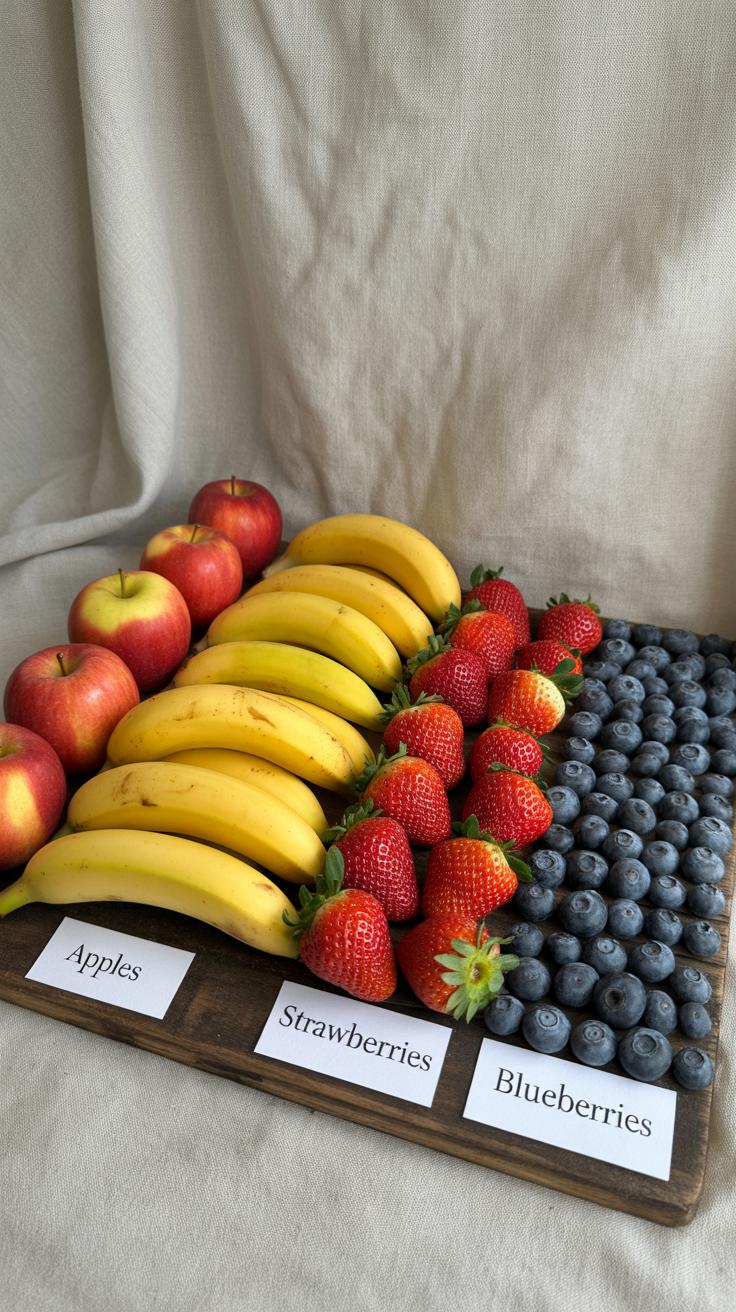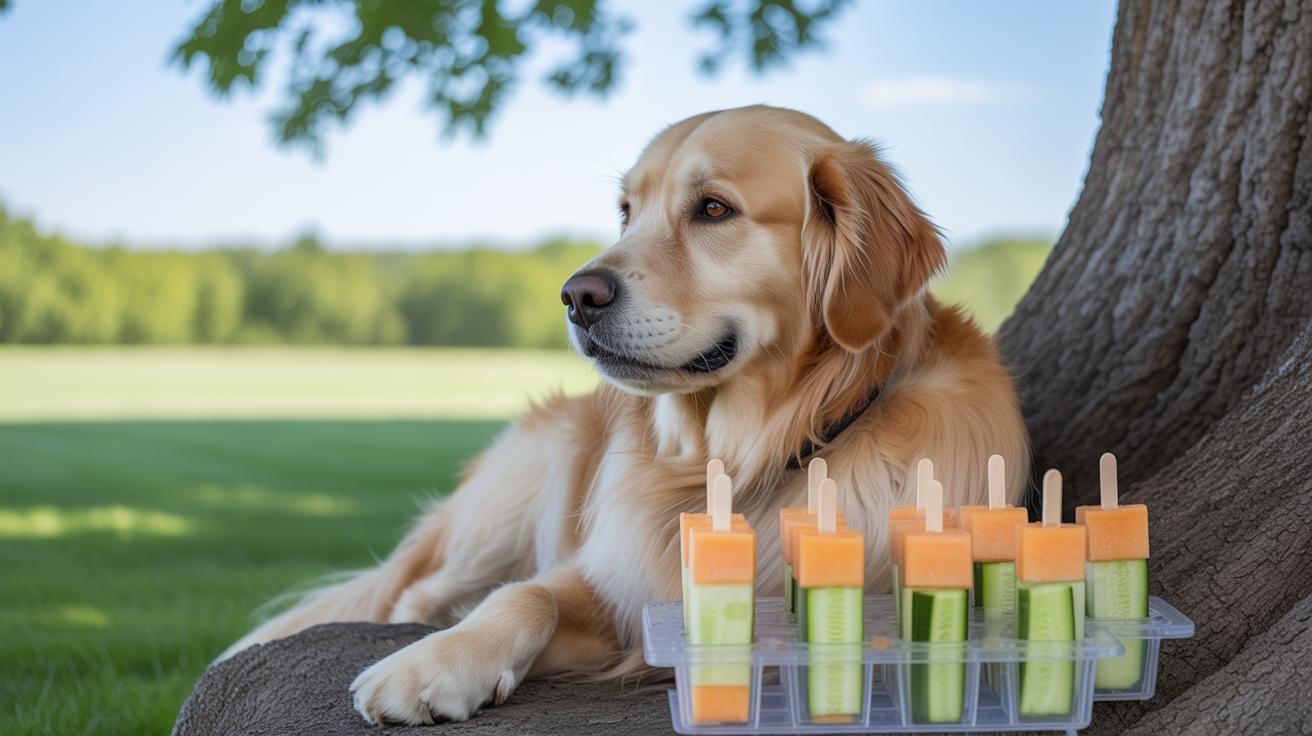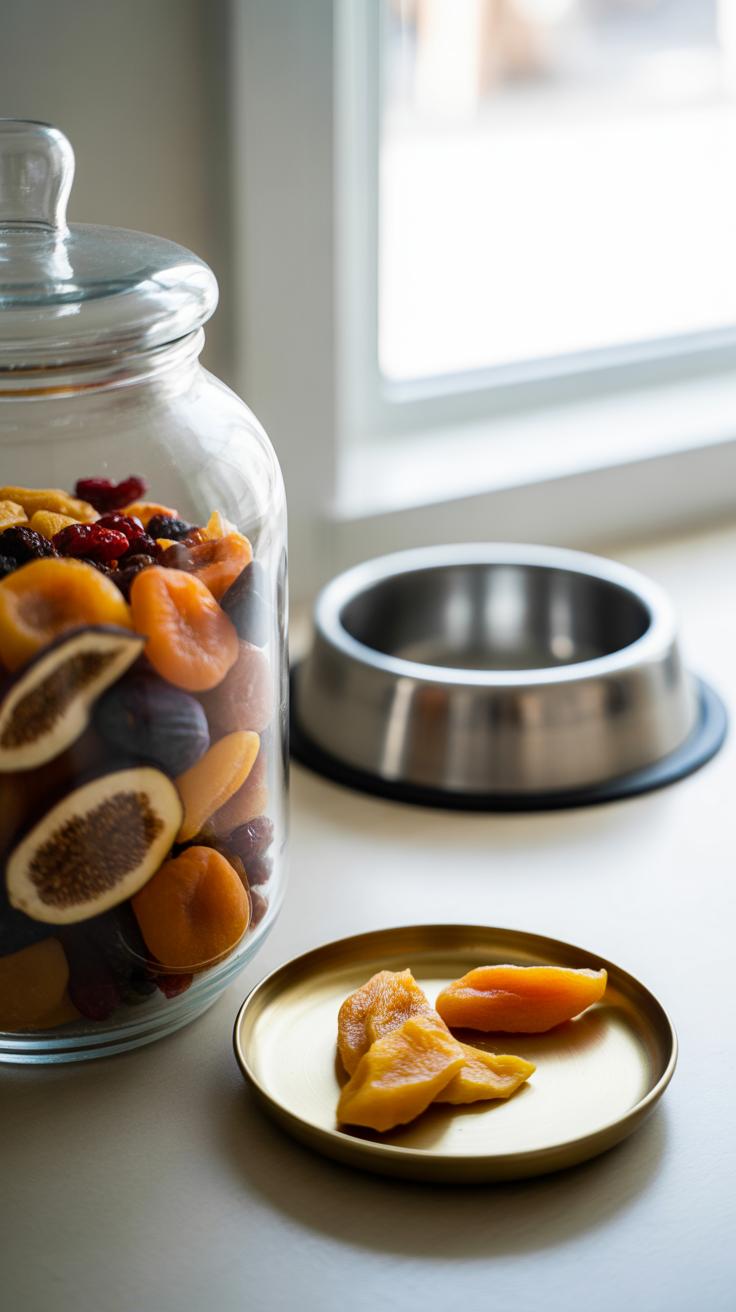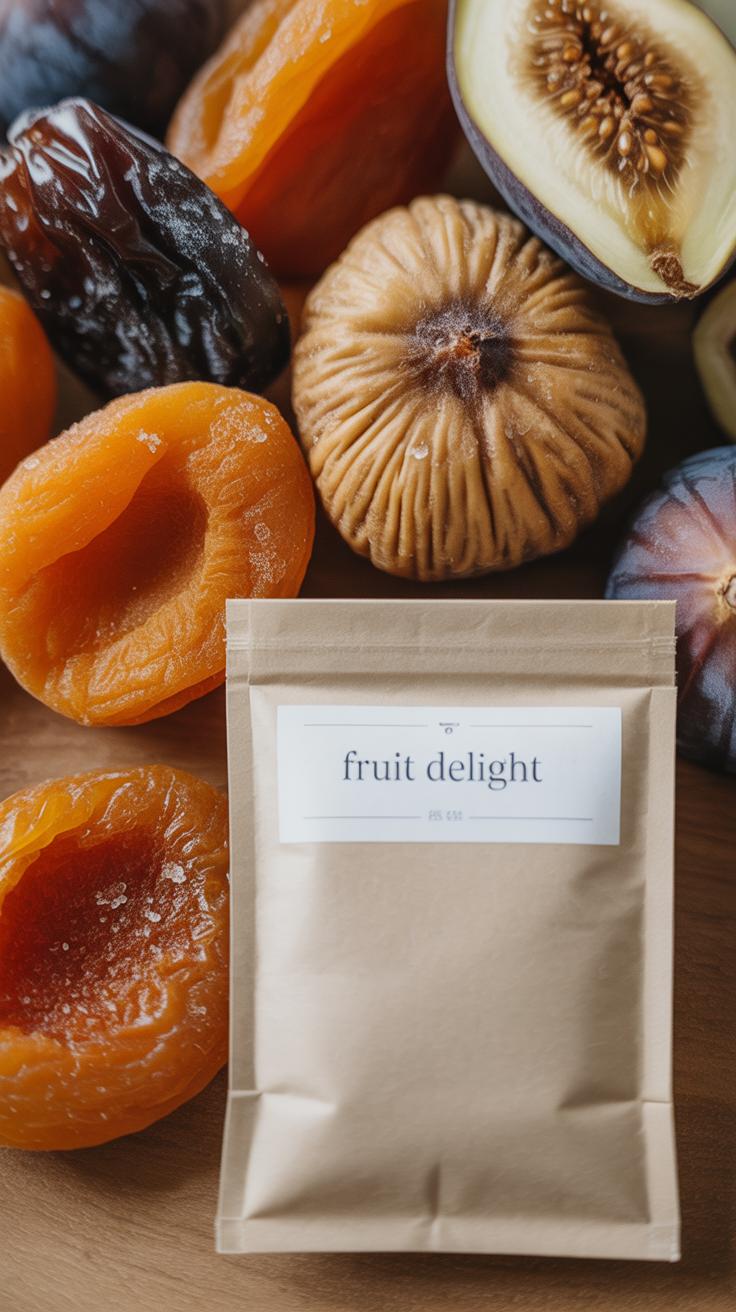Introduction
Dehydrated fruits offer a natural and tasty treat option for dogs. They concentrate the fruit’s flavors and nutrients while having longer shelf life without preservatives. This article explores how you can safely include dehydrated fruits in your dog’s diet and prepare them at home with simple steps.
We will discuss which fruits are safe for dogs, how to prepare them to retain nutritional benefits, and highlight key points to remember when offering dehydrated fruit treats to your furry friend. Understanding these details ensures you give your dog a healthy snack that complements their regular diet.
Understanding Dehydrated Fruit And Its Benefits For Dogs
What Is Dehydrated Fruit And How Is It Made
Dehydrated fruit is simply fruit with most of its water content removed. This drying process halts spoilage and concentrates the flavors. You might think this process is complicated, but it’s actually quite straightforward. Fruits are sliced, then dried either by air, sunlight, or using machines designed to draw out moisture.
Natural drying often means leaving fruit out in the sun or air, often for days. Industrial methods rely on dehydrators or ovens that keep a consistent low heat, speeding things up. Both approaches remove water but can affect texture and nutrient levels differently. The fruit shrinks, gets chewy or crisp, yet holds onto much of its original essence.
During dehydration, sugars become more concentrated. This might make the fruit taste sweeter, so portion control matters when offering treats to your dog. Importantly, the reduction in moisture means microbes struggle to survive, making these snacks safer and longer-lasting than their fresh counterparts.
Nutritional Benefits For Dogs
One reason dehydrated fruit works well for dogs is that many vitamins and minerals survive the drying process. For example, vitamin A and fiber tend to stay fairly stable. Even vitamin C, which often degrades with heat, can remain in small amounts depending on drying conditions.
Fiber is especially valuable. It supports digestion, something dogs benefit from, much like us. Dehydrated fruit packs this fiber densely because the water is gone. This makes it an easy way to add nutrients without overfeeding or adding fillers.
That said, some sensitive nutrients will fade with heat. So, nutrition is not exactly the same as fresh fruit’s. Still, the texture and natural sugars can encourage dogs to try something new, making dehydration a neat method to offer treats you feel better about.
Compared to processed fruit snacks designed for human consumption, dehydrated fruit typically lacks added sugars, preservatives, or artificial ingredients. This means fewer risks of upsetting your pup’s stomach or causing long-term health issues through unnecessary additives.
It really comes down to balance and knowing your dog’s preferences and needs. But when you want a simple, wholesome treat with a longer shelf life, dehydrated fruit often hits the mark.
Safe Fruits To Dehydrate For Dogs
When you think about dehydrating fruit for your dog, some options come to mind right away. Apples, for instance, are often a top pick. They’re packed with fiber and vitamin C, which might help digestion and immunity. Just peel them if you want and cut out the core—seeds can be a problem, so removing those is pretty necessary before drying.
Blueberries are another solid choice. They’re tiny, antioxidant-rich, and dogs usually love their sweet-tart taste. No prep really needed beyond washing, which makes them super easy. Drying concentrates their flavor and nutrients, making a snack both tasty and good for your pup.
Bananas work well, too. Their potassium supports muscle and nerve function. Peel them and slice thinly. Their natural sugars mean you’ll want to limit quantity—too much could upset your dog’s stomach. But in moderation, they’re usually quite a hit.
There are a few fruits you’ll definitely want to keep off your dog’s treats list. Grapes and raisins top the danger scale. Even in small amounts, these can cause severe kidney issues. It’s really best to avoid them entirely.
Also, any fruit with pits or large seeds—cherries, peaches, plums—pits hold cyanide compounds, which can be toxic. These seeds sometimes get stuck or cause choking hazards. If you’re set on those fruits, thorough pitting before dehydration is a must, but honestly, it’s often safer to skip them.
So, which fruits you choose matters quite a bit. Some are straightforward and offer real benefits without much hassle. Others are tricky, even risky, and should be left out or given with extreme care. It feels a bit like a balancing act, but once you find those safe, everyday options, you’ll likely feel more confident preparing your own snacks at home.
How To Dehydrate Fruit At Home For Your Dog
Preparing Fruit For Dehydration
Start by giving each fruit a good wash under cold running water. Dirt, pesticides, or residues can linger, and your dog’s health is worth that extra rinse. Peeling depends on the fruit—apples generally keep their peel, but peaches or plums should be peeled to avoid any pesticides or tough skins that might upset your dog’s tummy.
Removing seeds and pits is crucial. Seeds from cherries, peaches, plums, and apples contain small amounts of cyanide, which you don’t want your dog to ingest. Slice the fruit into even pieces, around a quarter-inch thick works well to ensure they dry thoroughly and evenly. Too thin, and they might turn to brittle dust; too thick, and they stay moist inside, which encourages spoilage.
Using Different Dehydration Methods
If you’ve got a food dehydrator, that’s usually your best bet. Set it to about 135°F and lay the fruit slices out without overlap. It often takes 6 to 12 hours, depending on the fruit and thickness. It’s kind of like babysitting—check occasionally but don’t obsess; patience matters here.
Oven drying works too, but it’s trickier to maintain low heat consistently. Keep your oven between 130° and 170°F, and if possible, leave the door slightly ajar to let moisture escape. It might take several hours, so keep an eye; the vigilance can feel a bit uneven.
Sun drying seems simple, but it’s weather-dependent and riskier — bugs and dust can settle on your fruit. If you try it, use a mesh cover and choose a clean, sunny spot with airflow, and expect it to take days rather than hours.
Whichever method you pick, make sure the fruit is completely dry and leathery, not sticky or wet. That final texture determines if your dog gets a safe treat or a potentially spoiled one. Have you noticed your fruit still slightly soft after drying? Better to dry it longer. Your dog’s snack deserves that care.
Storing And Serving Dehydrated Fruit Treats To Dogs
Keeping dehydrated fruit fresh can be trickier than you might think. Since these treats have low moisture, they can last a long time—but only if stored richtig. Ideally, keep them in airtight containers to prevent moisture and air from sneaking in. Glass jars with tight lids or resealable plastic bags work well. You want to avoid any humidity that could cause mold or spoilage.
Temperature matters too. A cool, dark place is best—your pantry or cupboard usually does the job. If your home is humid, maybe the fridge could help, but sometimes refrigeration can reintroduce moisture, which defeats the purpose. Generally, properly stored, dehydrated fruit can stay good anywhere from a few weeks to a couple of months. Always check for odd smells or textures before giving them to your pup.
When it comes to serving, size definitely counts. Small dogs should get tiny pieces, perhaps just a few bites a day. Larger dogs can handle a bit more, but try to keep fruit treats to under 10% of their daily calories. Too much sugar—even natural fruit sugar—can upset their tummy or cause weight gain. If your dog has any health issues like diabetes, best to talk to your vet first.
The frequency can vary, but I tend to offer fruit treats a few times a week as a special snack rather than everyday. Think of it like dessert—not the main course. I’ve noticed my dog starts asking for more if I feed them too often, so moderation keeps them special.
Potential Risks And How To Avoid Them
Feeding dehydrated fruit to your dog sounds simple enough, but there are a few pitfalls to keep in mind. One big concern is that dehydration concentrates the sugars in fruit. What was once a juicy, fresh piece becomes a dense, sugary snack that might not sit well with your dog’s system, especially if they’re prone to weight gain or diabetes. So even a small piece can pack a bigger punch than you expect.
Also, the drying process—especially if done at high heat—can change the fruit in ways you might not anticipate. For example, some nutrients might break down, and harmful compounds could form in trace amounts. It’s subtle, but it makes you wonder whether all drying methods are equally safe.
Then, there’s the issue of additives. Store-bought dehydrated fruits often contain preservatives, sulfur dioxide, or extra sugars. These aren’t great for dogs. I remember trying a “natural” dried fruit mix once and spotting ingredients that made me hesitant to share it with my pup at all. So, reading labels is a must.
Here’s how you can avoid trouble:
- Limit portions because sugar content is concentrated — just a small treat, not a whole snack bag.
- Choose low-heat dehydration techniques whenever you can, or better yet, make them yourself at home.
- Scan ingredients closely if buying from stores; avoid anything with added sugars, salt, or preservatives.
- If in doubt, consult your vet. Some fruits—even dried—can trigger allergies or digestive upset.
It’s a bit tricky juggling these risks, but staying cautious helps keep those fruity treats both safe and enjoyable for your dog.
Why Natural Treats Like Dehydrated Fruit Matter For Dogs
Natural treats have a place in your dog’s diet that goes beyond simple treats. They connect us back to whole foods, free from unnecessary additives. When you pick dehydrated fruit, you’re choosing snacks that don’t rely on artificial flavors or preservatives. That, in itself, can make a difference—perhaps not dramatic, but noticeable, especially if your dog has a sensitive stomach.
Fewer chemicals often mean easier digestion. Fruits in their natural state, when dehydrated carefully, keep many nutrients intact. That can add fiber, vitamins, and antioxidants to your dog’s treat time. The flavor also feels more authentic—something dogs might respond to more eagerly than the usual store-bought snacks.
Still, treats should never replace a balanced diet. Think of them as small extras that complement the main meal. It’s easy to slip into over-treating, especially when the option feels healthy. But your dog needs the right mix of protein, fats, and carbs first. Treats like dehydrated fruit fit best as occasional, thoughtful rewards rather than daily staples.
Comparing Dehydrated Fruit To Other Dog Treat Options
When you think about treats for your dog, commercial options often come to mind first. But dehydrated fruit stands apart in several notable ways. Unlike many store-bought treats, dehydrated fruit usually contains fewer chemicals. You’re not dealing with preservatives, artificial colors, or unknown additives. This can make a big difference for dogs with sensitive stomachs or allergies. Plus, you get to control the flavors by picking the fruits your dog enjoys. It’s a chance to tailor treats a bit more personally, not just grab what’s on the shelf.
Compared to raw fruit, dehydrated versions offer some practical perks. The longer shelf life means you won’t rush to give it before spoilage, and it’s easier to store. The flavors get concentrated too, which might make it more tempting for certain picky dogs. Though, of course, that can sometimes mean stronger sweetness than fresh pieces, which might not suit every pup’s palate. The convenience factor is hard to overlook—you can stash a bag in your bag without worrying about it squishing or going bad quickly.
But is dehydrated fruit always the better choice? Not necessarily. Commercial treats might have protein boosts or textures meant to clean teeth, while fresh fruit offers hydration you just don’t get from dried. Still, dehydrated fruit strikes a nice balance if you want natural, straightforward snacks that last and are pretty easy to prepare at home. It’s a solid option that feels a bit simpler and more honest than many alternatives.
Signs Your Dog Likes And Tolerates Dehydrated Fruit
When you introduce dehydrated fruit treats to your dog, watching their reaction can tell you a lot. Some dogs show clear excitement—they might wag their tail eagerly, perk their ears up, or even vocalize a bit when they see the treat. If your dog sits patiently or comes quickly when you offer the fruit, that’s often a good sign they enjoy it. Sometimes, dogs show subtle cues like licking their lips or sniffing the treat repeatedly before eating. These behaviors usually mean they’re curious and open to the new flavor.
Still, liking a treat doesn’t always mean it agrees with your pet’s system. It’s smart to keep an eye out for any digestive changes after giving dehydrated fruit. Watch for signs like loose stools, vomiting, or less obvious hints such as lethargy or scratching that might suggest an allergic reaction. Sometimes, symptoms can show up hours later or even the next day. Some dogs might be okay with certain fruits but not others, so testing a small portion first and observing for a few days is a cautious approach.
It can be tricky—your dog may seem to love a treat but tolerate it only in small amounts. So, if you notice any unusual behaviors or stomach issues, it’s a good idea to pause and rethink. After all, the goal is for these snacks to be a safe and tasty addition, not something that causes discomfort.
Easy Recipes And Ideas To Make Dehydrated Fruit Treats
Sometimes, the simplest treats really are the best. Just take dried apple slices, for example. Slice a fresh apple thinly, remove the core, and dehydrate until crisp. Your dog gets a crunchy, naturally sweet snack that feels a bit special without much effort. Banana chips, dried just enough to lose moisture but keep their softness, work the same way. It’s straightforward, really — just fruit, minimal prep, and a treat that feels homemade.
But there’s no need to stop at single-fruit treats. Combining dehydrated fruit with other dog-safe ingredients opens up more fun options. Think about mixing dried blueberries or cranberries into plain yogurt drops before freezing. The cool yogurt softens the berries, making it an easy-to-handle treat for your pup. Or you can dip dried apple pieces lightly into peanut butter—nothing fancy—just a little coating that adds flavor and a bit of protein.
Some dog owners find layering dehydrated fruit bits into homemade biscuit dough interesting. While baking, the fruit softens just enough, adding texture and taste without overwhelming. It’s worth testing a few ideas and seeing what your dog prefers—and dare I say, which you enjoy making most. Do you want crunchy? Soft? Sweet or subtle? There’s no firm rule here, just options that you can tweak to fit your dog’s palate and your schedule.
Conclusions
Choosing the right dehydrated fruits and preparing them safely can add variety and health benefits to your dog’s treats. Fresh fruits carefully dehydrated preserve good nutrients and offer natural sweetness dogs enjoy. Always double-check for any harmful fruits and avoid additives.
By following simple preparation methods and knowing which dehydrated fruits to select, you provide your dog with safe snacks that support their nutrition. These natural treats add joy to their diet without harmful ingredients, helping you care for your dog’s health in a tasty way.






















